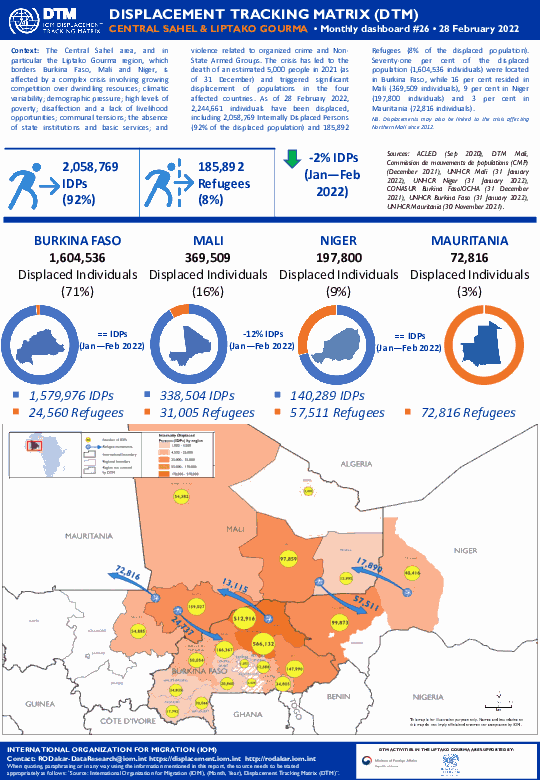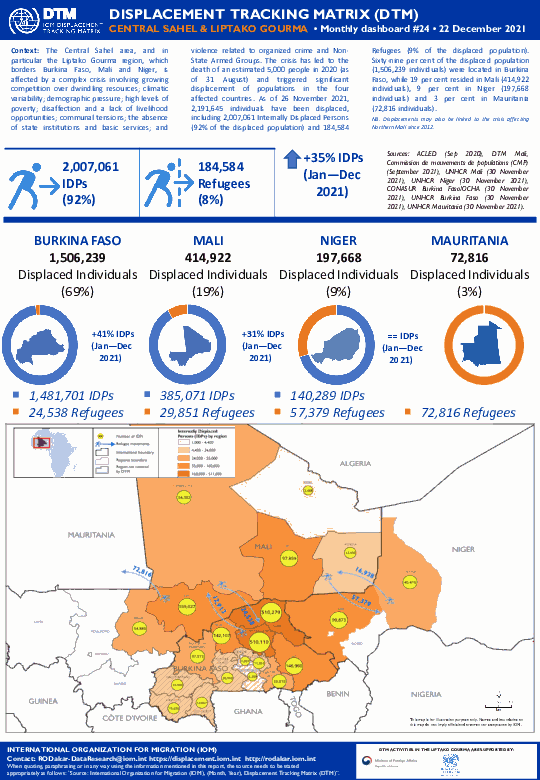-
Countries
-
Data and Analysis
-
Special Focus
-
Crisis Responses
Liptako Gourma Crisis Monthly Dashboard
Title Standard
West and Central Africa — Liptako Gourma Crisis Monthly Dashboard # (DATE)
Contact
RO Dakar, RODakar-DataResearch@iom.int
Type
Component
Domain
Confidential
Region
The Central Sahel area, and in particular the Liptako Gourma region, which borders Burkina Faso, Mali and Niger, is affected by a complex crisis involving growing competition over dwindling resources; climatic variability; demographic pressure; high levels of poverty; disaffection and a lack of livelihood opportunities; communal tensions; the absence of state institutions and basic services; and violence related to organized crime and Non-State Armed Groups. The crisis has led to the death of an estimated 5,000 people in 2021 (as of 31 December) and triggered significant displacement of populations in the four affected countries.
As of 30 September 2022, 2,712,679 individuals have been displaced, including 2,492,514 Internally Displaced Persons (92% of the displaced population) and 220,165 Refugees (8% of the displaced population). Seventy-two per cent of the displaced population (1,928,759 individuals) were located in Burkina Faso, while 16 per cent resided in Mali (461,751 individuals), 9 per cent in Niger (231,929 individuals) and 3 per cent in Mauritania (90,240 individuals).
NB: Displacements may also be linked to the crisis affecting Northern Mali since 2012.
The Central Sahel area, and in particular the Liptako Gourma region, which borders Burkina Faso, Mali and Niger, is affected by a complex crisis involving growing competition over dwindling resources; climatic variability; demographic pressure; high levels of poverty; disaffection and a lack of livelihood opportunities; communal tensions; the absence of state institutions and basic services; and violence related to organized crime and Non-State Armed Groups. The crisis has led to the death of an estimated 5,000 people in 2021 (as of 31 December) and triggered significant displacement of populations in the four affected countries.
As of 31 July 2022, 2,641,697 individuals have been displaced, including 2,437,354 Internally Displaced Persons (92% of the displaced population) and 204,343 Refugees (8% of the displaced population). Seventy-three per cent of the displaced population (1,902,150 individuals) were located in Burkina Faso, while 15 per cent resided in Mali (406,184 individuals), 8 per cent in Niger (223,524 individuals) and 3 per cent in Mauritania (85,083 individuals).
The Central Sahel area, and in particular the Liptako Gourma region, which borders Burkina Faso, Mali and Niger, is affected by a complex crisis involving growing competition over dwindling resources; climatic variability; demographic pressure; high levels of poverty; disaffection and a lack of livelihood opportunities; communal tensions; the absence of state institutions and basic services; and violence related to organized crime and Non-State Armed Groups. The crisis has led to the death of an estimated 5,000 people in 2021 (as of 31 December) and triggered significant displacement of populations in the four affected countries.
As of 30 June 2022, 2,641,477 individuals have been displaced, including 2,437,354 Internally Displaced Persons (92% of the displaced population) and 204,123 Refugees (8% of the displaced population). Seventy-three per cent of the displaced population (1,902,150 individuals) were located in Burkina Faso, while 15 per cent resided in Mali (406,184 individuals), 8 per cent in Niger (223,304 individuals) and 3 per cent in Mauritania (85,083 individuals).
The Central Sahel area, and in particular the Liptako Gourma region, which borders Burkina Faso, Mali and Niger, is affected by a complex crisis involving growing competition over dwindling resources; climatic variability; demographic pressure; high levels of poverty; disaffection and a lack of livelihood opportunities; communal tensions; the absence of state institutions and basic services; and violence related to organized crime and Non-State Armed Groups. The crisis has led to the death of an estimated 5,000 people in 2021 (as of 31 December) and triggered significant displacement of populations in the four affected countries. As of 25 May 2022, 2,562,457 individuals have been displaced, including 2,361,130 Internally Displaced Persons (92% of the displaced population) and 201,328 Refugees (8% of the displaced population). Seventy-three per cent of the displaced population (1,875,049 individuals) were located in Burkina Faso, while 16 per cent resided in Mali (400,517 individuals), 8 per cent in Niger (202,366 individuals) and 3 per cent in Mauritania (84,526 individuals).
The Central Sahel area, and in particular the Liptako Gourma region, which borders Burkina Faso, Mali and Niger, is affected by a complex crisis involving growing competition over dwindling resources; climatic variability; demographic pressure; high levels of poverty; disaffection and a lack of livelihood opportunities; communal tensions; the absence of state institutions and basic services; and violence related to organized crime and Non-State Armed Groups. The crisis has led to the death of an estimated 5,000 people in 2021 (as of 31 December) and triggered significant displacement of populations in the four affected countries. As of 30 April 2022, 2,523,618 individuals have been displaced, including 2,317,479 Internally Displaced Persons (92% of the displaced population) and 206,139 Refugees (8% of the displaced population). Seventy-three per cent of the displaced population (1,839,039 individuals) were located in Burkina Faso, while 16 per cent resided in Mali (402,138 individuals), 8 per cent in Niger (202,068 individuals) and 3 per cent in Mauritania (80,373 individuals).
The Central Sahel area, and in particular the Liptako Gourma region, which borders Burkina Faso, Mali and Niger, is affected by a complex crisis involving growing competition over dwindling resources; climatic variability; demographic pressure; high levels of poverty; disaffection and a lack of livelihood opportunities; communal tensions; the absence of state institutions and basic services; and violence related to organized crime and Non-State Armed Groups. The crisis has led to the death of an estimated 5,000 people in 2021 (as of 31 December) and triggered significant displacement of populations in the four affected countries. As of 28 March 2022, 2,492,342 individuals have been displaced, including 2,293,076 Internally Displaced Persons (92% of the displaced population) and 199,266 Refugees (8% of the displaced population). Seventy-four per cent of the displaced population (1,839,023 individuals) were located in Burkina Faso, while 15 per cent resided in Mali (375,083 individuals), 8 per cent in Niger (201,823 individuals) and 3 per cent in Mauritania (76,413 individuals).
The Central Sahel area, and in particular the Liptako Gourma region, which borders Burkina Faso, Mali and Niger, is affected by a complex crisis involving growing competition over dwindling resources; climatic variability; demographic pressure; high levels of poverty; disaffection and a lack of livelihood opportunities; communal tensions; the absence of state institutions and basic services; and violence related to organized crime and Non-State Armed Groups. The crisis has led to the death of an estimated 5,000 people in 2021 (as of 31 December) and triggered significant displacement of populations in the four affected countries. As of 28 February 2022, 2,244,661 individuals have been displaced, including 2,058,769 Internally Displaced Persons (92% of the displaced population) and 185,892 Refugees (8% of the displaced population). Seventy-one per cent of the displaced population (1,604,536 individuals) were located in Burkina Faso, while 16 per cent resided in Mali (369,509 individuals), 9 per cent in Niger (197,800 individuals) and 3 per cent in Mauritania (72,816 individuals).
The Central Sahel area, and in particular the Liptako Gourma region, which borders Burkina Faso, Mali and Niger, is affected by a complex crisis involving growing competition over dwindling resources; climatic variability; demographic pressure; high levels of poverty; disaffection and a lack of livelihood opportunities; communal tensions; the absence of state institutions and basic services; and violence related to organized crime and Non-State Armed Groups. The crisis has led to the death of an estimated 5,000 people in 2021 (as of 31 December) and triggered significant displacement of populations in the four affected countries. As of 25 January 2022, 2,295,207 individuals have been displaced, including 2,105,336 Internally Displaced Persons (92% of the displaced population) and 189,871 Refugees (8% of the displaced population). Seventy per cent of the displaced population (1,604,536 individuals) were located in Burkina Faso, while 18 per cent resided in Mali (416,076 individuals), 9 per cent in Niger (201,779 individuals) and 3 per cent in Mauritania (72,816 individuals).
The Central Sahel area, and in particular the Liptako Gourma region, which borders Burkina Faso, Mali and Niger, is affected by a complex crisis involving growing competition over dwindling resources; climatic variability; demographic pressure; high levels of poverty; disaffection and a lack of livelihood opportunities; communal tensions; the absence of state institutions and basic services; and violence related to organized crime and Non-State Armed Groups. The crisis has led to the death of an estimated 5,000 people in 2020 (as of 31 August) and triggered significant displacement of populations in the four affected countries. As of 26 November 2021, 2,191,645 individuals have been displaced, including 1,506,239 Internally Displaced Persons (92% of the displaced population) and 184,584 Refugees (9% of the displaced population). Sixty-nine per cent of the displaced population (1,506,239 individuals) were located in Burkina Faso, while 19 per cent resided in Mali (414,922 individuals), 9 per cent in Niger (197,668 individuals) and 3 per cent in Mauritania (72,816 individuals).
The Central Sahel area, and in particular the Liptako Gourma region, which borders Burkina Faso, Mali and Niger, is affected by a complex crisis involving growing competition over dwindling resources; climatic variability; demographic pressure; high levels of poverty; disaffection and a lack of livelihood opportunities; communal tensions; the absence of state institutions and basic services; and violence related to organized crime and Non-State Armed Groups. The crisis has led to the death of an estimated 5,000 people in 2020 (as of 31 August) and triggered significant displacement of populations in the four affected countries. As of 26 November 2021, 2,116,685 individuals have been displaced, including 1,933,045 Internally Displaced Persons (91% of the displaced population) and 183,640 Refugees (9% of the displaced population). Sixty-eight per cent of the displaced population (1,431,279 individuals) were located in Burkina Faso, while 20 per cent resided in Mali (414,922 individuals), 9 per cent in Niger (197,668 individuals) and 3 per cent in Mauritania (72,816 individuals).
Pagination
- Previous page
- Page 2
- Next page










